ASUS M2N32-SLI & Epox MF570SLI: AM2 Wunderkinder
by Wesley Fink on June 28, 2006 5:10 AM EST- Posted in
- Motherboards
Gaming Performance
We tested with our recently revised group of game tests, which includes Call of Duty 2, Serious Sam 2, Half Life 2: Lost Coast, F.E.A.R, Far Cry, and Splinter Cell: Chaos Theory. All boards were tested with the NVIDIA 7900GTX using NVIDIA 91.27 drivers. The ATI Reference Board was additionally tested with a single ATI X1900XT with Catalyst 6.4 drivers for Reference.
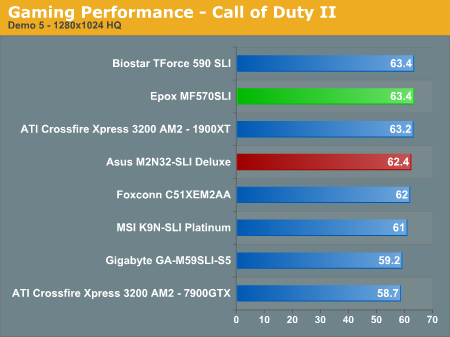
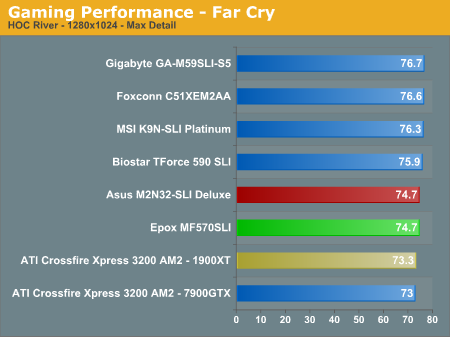
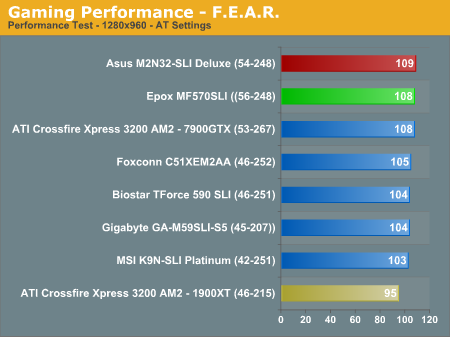
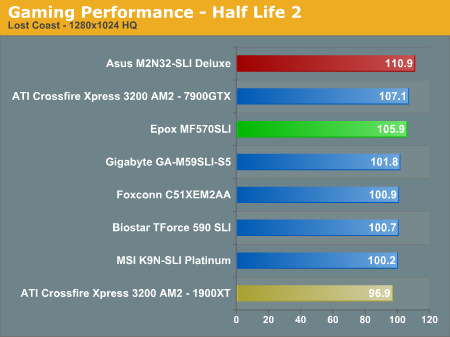

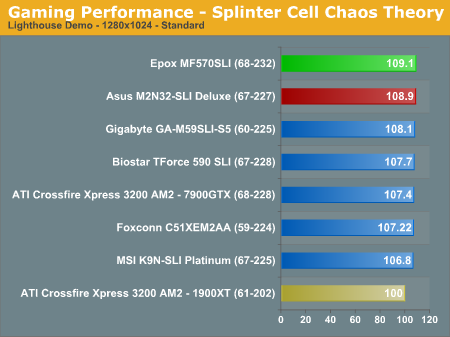
ASUS M2N32-SLI Deluxe results are in red and Epox MF570SLI results are in bright green. It was a bit of a surprise that both these boards finished at or near the top of standard gaming performance. The ASUS generally provided best results among the seven tested boards, followed closely by the Epox MF570SLI.
SLI/CrossFire Gaming Performance
Both major players in the Video Market now have flagship Dual X16 solutions. SLI and CrossFire are about gaming, so dual video tests were confined to gaming benchmarks, and the test suite is heavily slanted to recent and popular titles where SLI and CrossFire make the biggest difference. All dual video testing was at 1600x1200, 4xAA, and 8xAF. Tests were also run with a single X1900XT at this same resolution. The single video high-res results on the ATI AM2 are in Orange and the CrossFire results are in Red.
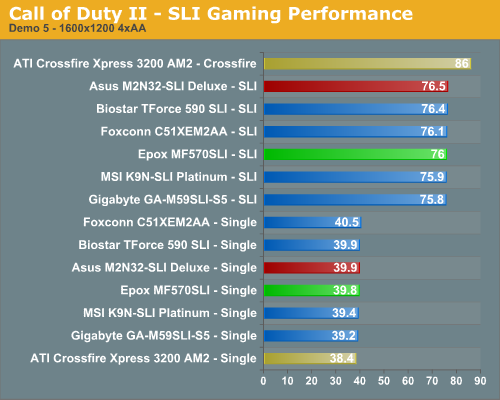
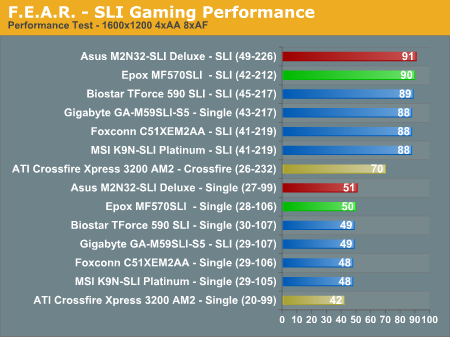
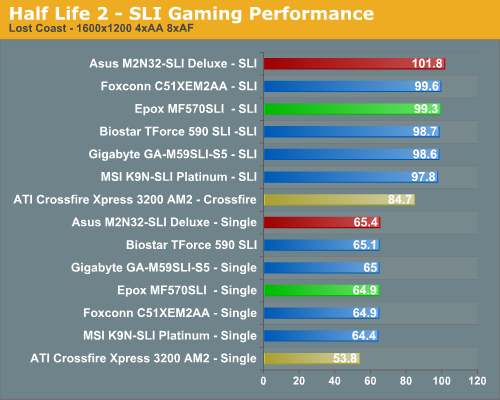
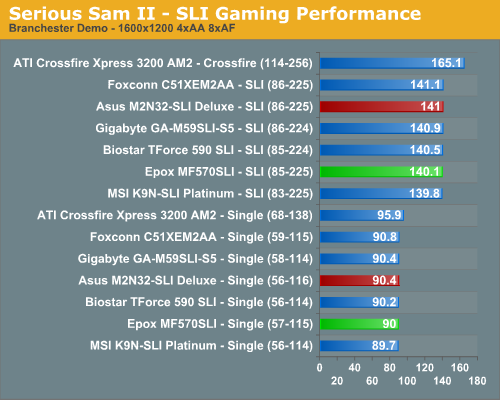
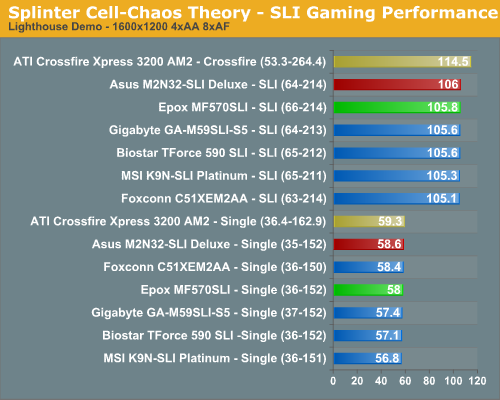
You might think you are looking at results from different video cards in CrossFire/SLI performance. Here leads are larger and positions are often switched from results at standard resolution without the eye candy. ATI CrossFire is the clear winner in Serous Sam2, COD2, and Splinter Cell-Chaos Theory, while NVIDIA SLI owns Half Life 2 and F.E.A.R. Part of these multi-GPU results revolve around which card has optimized drivers available, and ATI just announced Catalyst 6.6 drivers with promised significant performance improvements in F.E.A.R. and HL2. The new 6.6 drivers will be used for testing the retail ATI AM2 motherboards in Part 4 of the AM2 Motherboard Roundup. Among NVIDIA 500 based motherboards, the ASUS and Epox were normally at or near the top of the SLI performance charts.
We tested with our recently revised group of game tests, which includes Call of Duty 2, Serious Sam 2, Half Life 2: Lost Coast, F.E.A.R, Far Cry, and Splinter Cell: Chaos Theory. All boards were tested with the NVIDIA 7900GTX using NVIDIA 91.27 drivers. The ATI Reference Board was additionally tested with a single ATI X1900XT with Catalyst 6.4 drivers for Reference.






ASUS M2N32-SLI Deluxe results are in red and Epox MF570SLI results are in bright green. It was a bit of a surprise that both these boards finished at or near the top of standard gaming performance. The ASUS generally provided best results among the seven tested boards, followed closely by the Epox MF570SLI.
SLI/CrossFire Gaming Performance
Both major players in the Video Market now have flagship Dual X16 solutions. SLI and CrossFire are about gaming, so dual video tests were confined to gaming benchmarks, and the test suite is heavily slanted to recent and popular titles where SLI and CrossFire make the biggest difference. All dual video testing was at 1600x1200, 4xAA, and 8xAF. Tests were also run with a single X1900XT at this same resolution. The single video high-res results on the ATI AM2 are in Orange and the CrossFire results are in Red.





You might think you are looking at results from different video cards in CrossFire/SLI performance. Here leads are larger and positions are often switched from results at standard resolution without the eye candy. ATI CrossFire is the clear winner in Serous Sam2, COD2, and Splinter Cell-Chaos Theory, while NVIDIA SLI owns Half Life 2 and F.E.A.R. Part of these multi-GPU results revolve around which card has optimized drivers available, and ATI just announced Catalyst 6.6 drivers with promised significant performance improvements in F.E.A.R. and HL2. The new 6.6 drivers will be used for testing the retail ATI AM2 motherboards in Part 4 of the AM2 Motherboard Roundup. Among NVIDIA 500 based motherboards, the ASUS and Epox were normally at or near the top of the SLI performance charts.










23 Comments
View All Comments
Missing Ghost - Wednesday, June 28, 2006 - link
yep the choice of I/O ports on the back panel is pretty poorLarso - Wednesday, June 28, 2006 - link
Perhaps someone should clarify this for me. I have been noticing how there is a growing interest in how the motherboard makers have done the power conversion for the CPU. Why has this become an issue to investigate?I don't think there was a similar focus on the power converters for the netburst chips, which I believe soaked a lot more juice than these AMD chips. I believe they managed to deliver stable power to the netbursts without needing an 8 phase converter cooled by heatpipes??
I'm fearing that the motherboard producers will start to create extravagant and foolishly designed converters to please the reviewers. I believe there is no good reason to go for an 8 phase design, when a 4 phase would do the job, considering the money that can be spend on each phase. And that ASUS need to cool the converter by heatpipe seems to indicate that the convertion have a bad effeciency, is this really a step forward?
I really enjoy reading more about the technical solutions on the motherboards, but it just seems to me that the power converter should be less of an issue now, than with the power hungry netburts?
Operandi - Friday, June 30, 2006 - link
A 8 phase design is more efficient then a 4 phase, not less.Missing Ghost - Wednesday, June 28, 2006 - link
It seems to me that the heatpipes are more for cooling the chipset in fact.erwos - Wednesday, June 28, 2006 - link
What WiFi chipset does it use? "It has WiFi" is not terribly precise.-Erwos
Wesley Fink - Wednesday, June 28, 2006 - link
The WiFi chip used on the Asus WiFi module is Realtek RTL8187L. The Features have been updated to reflect this.Wesley Fink - Wednesday, June 28, 2006 - link
Asus refers to the Wi-Fi in specifications as "WiFi Home USB wireless module supporting IEE 802.11 b/g". There is no mention at all of the supporting chip. The module is attached to the motherboard and the chip is loacated behind heatpipes. We can't read the model number, but the logo is clearly Realtek.highlnder69 - Wednesday, June 28, 2006 - link
On page 8 under Half Life 2 - SLI Gaming Performance, I think that the Asus Single/SLI results are labeled incorrectly. It's currently showing the Single card configuration with the highest FPS results and the SLI with the lowest.Wesley Fink - Wednesday, June 28, 2006 - link
You are correct, the labels were reversed. They are now corrected.DigitalFreak - Wednesday, June 28, 2006 - link
Someone needs to teach the idiots at Asus about how to design the proper motherboard layout. With an SLI setup with dual width cards, there's no PCI-E slots available.